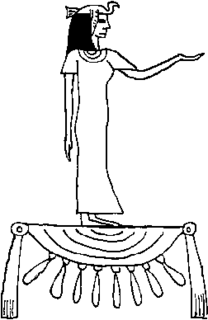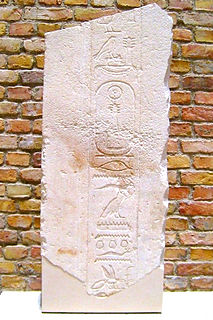
Unas or Wenis, also spelled Unis, was a pharaoh, the ninth and last ruler of the Fifth Dynasty of Egypt during the Old Kingdom. Unas reigned for 15 to 30 years in the mid-24th century BC, succeeding Djedkare Isesi, who might have been his father.

Neferneferuaten Nefertiti was an Egyptian queen and the Great Royal Wife of Akhenaten, an Egyptian Pharaoh. Nefertiti and her husband were known for a religious revolution, in which they worshiped one god only, Aten, or the sun disc. With her husband, she reigned at what was arguably the wealthiest period of Ancient Egyptian history. Some scholars believe that Nefertiti ruled briefly as Neferneferuaten after her husband's death and before the accession of Tutankhamun, although this identification is a matter of ongoing debate. If Nefertiti did rule as Pharaoh, her reign was marked by the fall of Amarna and relocation of the capital back to the traditional city of Thebes.

In Egyptian mythology, Heryshaf, or Hershef,, transcribed in Greek as Harsaphes was an ancient ram deity whose cult was centered in ancient Heracleopolis Magna. He was identified with Ra and Osiris in ancient Egyptian religion, as well as Dionysus or Heracles in the interpretatio graeca. The identification with Heracles may be related to the fact that in later times his name was sometimes reanalysed as ḥrj-šf.t "He who is over strength". One of his titles was "Ruler of the Riverbanks". Heryshaf was a creator and fertility god who was born from the primordial waters. He was pictured as a ram or a man with a ram's head.

In Egyptian mythology, Meret was a goddess who was strongly associated with rejoicing, such as singing and dancing.
The Sixth Dynasty of ancient Egypt along with Dynasties III, IV and V constitute the Old Kingdom of Dynastic Egypt.

Menkauhor Kaiu was an Ancient Egyptian pharaoh of the Old Kingdom period. He was the seventh ruler of the Fifth Dynasty at the end of the 25th century BC or early in the 24th century BC.

Djedkare Isesi was a pharaoh, the eighth and penultimate ruler of the Fifth Dynasty of Egypt in the late 25th century to mid-24th century BC, during the Old Kingdom. Djedkare succeeded Menkauhor Kaiu and was in turn succeeded by Unas. His relations to both of these pharaohs remain uncertain, although it is often conjectured that Unas was Djedkare's son, owing to the smooth transition between the two.

Meret Elisabeth Oppenheim was a German-born Swiss Surrealist artist and photographer. Oppenheim was a member of the Surrealist movement along with André Breton, Luis Buñuel, Max Ernst, and other writers and visual artists. Besides creating art objects, Oppenheim also famously appeared as a model for photographs by Man Ray, most notably a series of nude shots of her interacting with a printing press.

The Pyramid of Djedkare Isesi is the pyramid complex built for the Fifth Dynasty pharaoh Djedkare Isesi sometime around the late 25th, to mid 24th century BC. It was the first pyramid to be built at South Saqqara. The pyramid is referred to as Haram el-Shawaf, meaning 'Sentinel Pyramid', by the locals.
Wadi Maghareh, is an archaeological site located in the southwestern Sinai Peninsula, Egypt. It contains pharaonic monuments and turquoise mines dating from the Old, Middle and New Kingdoms of Ancient Egypt. The Ancient Egyptians knew the site as "the Terraces of Turquoise."

Meresankh IV was a queen of Egypt in the 5th dynasty. Her name means "she loves life". While some sources consider that her husband is unknown, other sources suggest her husband was Pharaoh Menkauhor Kaiu. It is also possible that Meresankh was the wife of Djedkare Isesi.
Hedjetnebu (Hedjetnub) was a Princess of Egypt who lived during the 5th dynasty. Her father was Pharaoh Djedkare.

Isesi-ankh was an Ancient Egyptian high official during the second half of the Fifth Dynasty, in the late 25th to mid 24th century BC. His name means "Isesi lives". He may have been a son of pharaoh Djedkare Isesi and queen Meresankh IV, although this is debated. Isesi-ankh probably lived during the reign of Djedkare Isesi and that of his successor Unas. He was buried in a mastaba tomb in north Saqqara, now ruined.

Senedjemib Inti was a vizier from the Fifth dynasty of Egypt during the reign of king Djedkare Isesi.

Senedjemib Mehi was a vizier from the fifth dynasty of Egypt. Senedjemib Mehi started out his career under Djedkare Isesi and eventually became vizier under Unas.
Articles related to ancient Egypt include:

Tisethor was a princess of ancient Egypt, a daughter of Princess Kekheretnebti and granddaughter of the King Djedkare Isesi. Her father is not known. She was a niece of Neserkauhor, Meret-Isesi and Isesi-ankh.

Mereret was an Ancient Egyptian King's Daughter known from her burial next to the Pyramid of Pharaoh Senusret III at Dahshur. On the north side of the king's pyramid was a row of four pyramids belonging to the king's wives. These pyramids were connected by an underground gallery. On the west side of the gallery were further burials arranged for women with the title king's daughter. They were buried in sarcophagi that were placed into niches. All burials were found looted. However, the robbers missed two boxes filled with personal adornments found in 1894 by Jacques de Morgan. One of these boxes must have belonged to a king's daughter Sithathor, the other box to a king's daughter with the name Mereret or Meret.
















